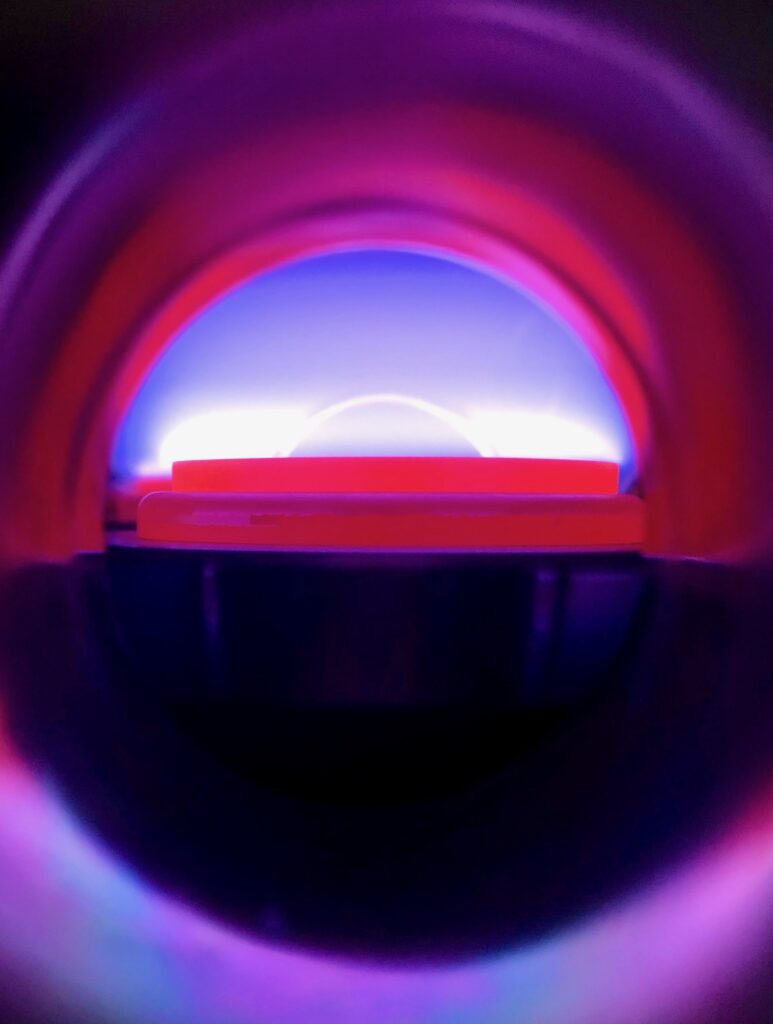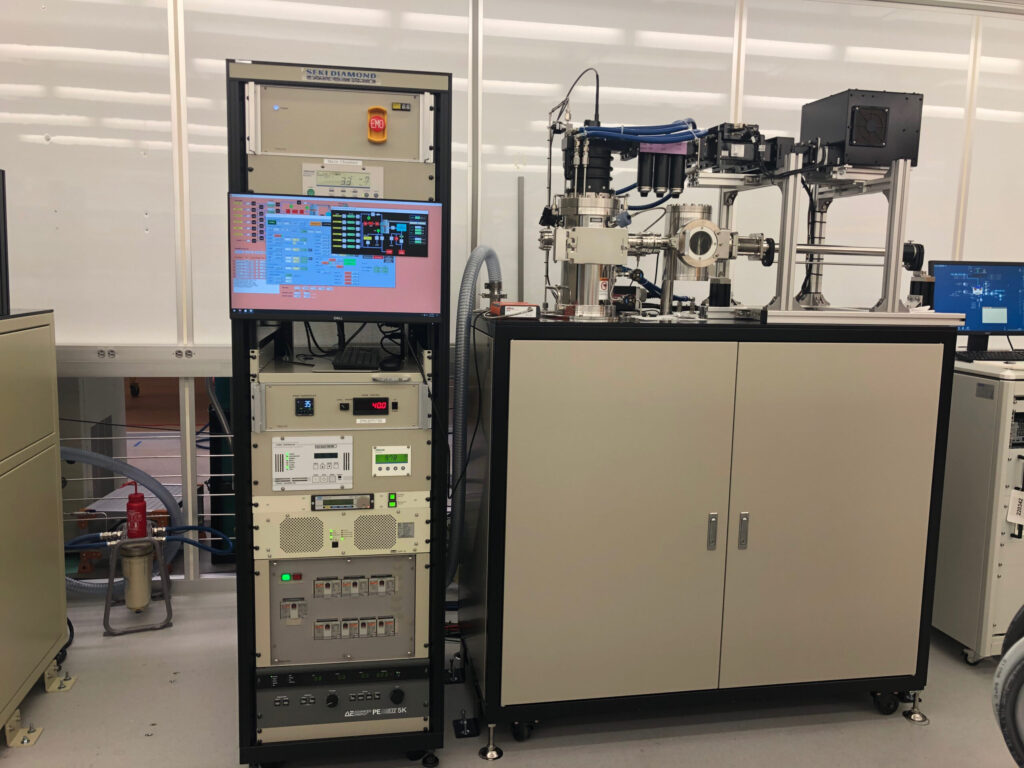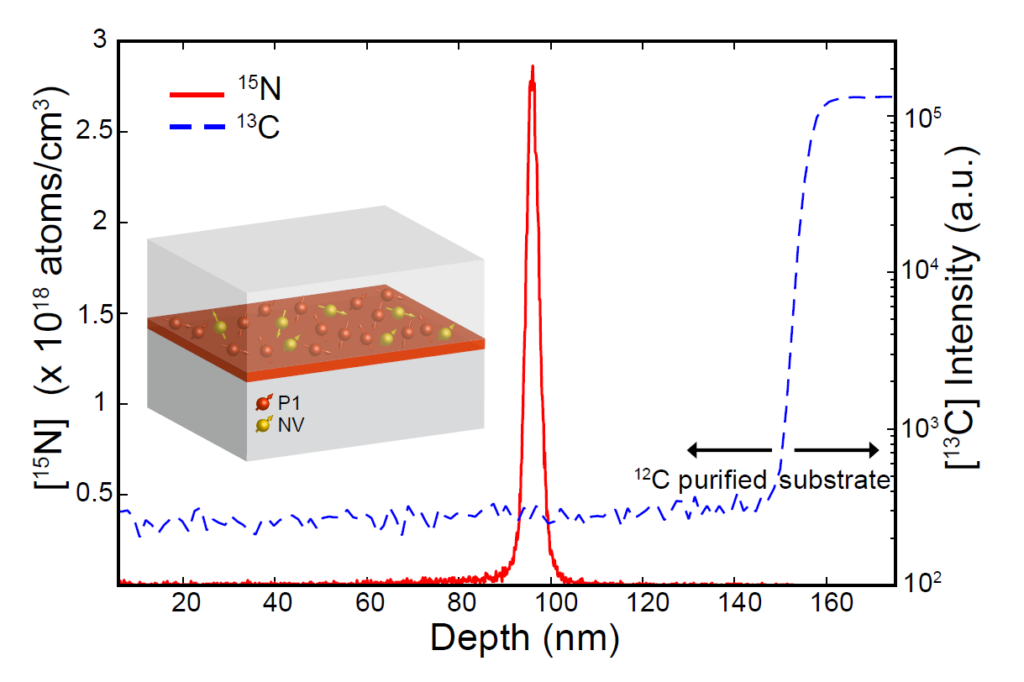


Diamond Growth and Defect Engineering
We grow high purity diamond in-house using plasma-enhanced chemical vapor deposition (PECVD). This allows us to create a high-quality lattice environment for hosting defects with long spin coherence and gives control over the defect formation process. We have developed methods to create high density, thin layers of nitrogen within the diamond and are currently working to push nitrogen incorporation to the high density limit while striving to better understand the underlying growth mechanisms. We are also experimenting with bringing the nitrogen layers close to the diamond surface to create shallow NV centers using for quantum sensing experiments.
Underlying our diamond growth studies is the desire to better understand and control defect formation. We are interested in employing fermi level engineering techniques to influence defect formation dynamics and charge states, and we are actively working on this by studying the diamond surface termination and passivation. We aim to bring a materials science and defect engineering perspective to create more robust and coherent solid-state qubits for a wide variety of experiments in quantum sensing and simulation.
Underlying our diamond growth studies is the desire to better understand and control defect formation. We are interested in employing fermi level engineering techniques to influence defect formation dynamics and charge states, and we are actively working on this by studying the diamond surface termination and passivation. We aim to bring a materials science and defect engineering perspective to create more robust and coherent solid-state qubits for a wide variety of experiments in quantum sensing and simulation.
Publications
Two-dimensional spin systems in PECVD-grown diamond with tunable density and long coherence for enhanced quantum sensing and simulation – APL Materials 11, 021101 (2023)
Materials challenges for quantum technologies based on color centers in diamond – MRS Bulletin 46, 623–633 (2021)
Optimizing the formation of depth-confined nitrogen vacancy center spin ensembles in diamond for quantum sensing – Phys. Rev. Materials 3, 113802 (2019)
Identifying and mitigating charge instabilities in shallow diamond nitrogen-vacancy centers – Phys. Rev. Lett. 122, 076101 (2019)
Double-Quantum Spin-Relaxation Limits to Coherence of Near-Surface Nitrogen-Vacancy Centers – Phys. Rev. Lett. 118, 197201 (2017)
Hyperfine-enhanced gyromagnetic ratio of a nuclear spin in diamond – New Journal of Physics 18, 083016 (2016)
Patterned Formation of Highly Coherent Nitrogen-Vacancy Centers Using a Focused Electron Irradiation Technique – Nano Lett. ASAP (2016)
Probing surface noise with depth-calibrated spins in diamond – Phys. Rev. Lett., 113, 027602 (2014)
Three-dimensional localization of spins in diamond using 12C implantation – Appl. Phys. Lett. 105, 052406 (2014)
Engineering shallow spins in diamond with nitrogen delta-doping – Appl. Phys. Lett. 101, 082413 (2012)
Materials challenges for quantum technologies based on color centers in diamond – MRS Bulletin 46, 623–633 (2021)
Optimizing the formation of depth-confined nitrogen vacancy center spin ensembles in diamond for quantum sensing – Phys. Rev. Materials 3, 113802 (2019)
Identifying and mitigating charge instabilities in shallow diamond nitrogen-vacancy centers – Phys. Rev. Lett. 122, 076101 (2019)
Double-Quantum Spin-Relaxation Limits to Coherence of Near-Surface Nitrogen-Vacancy Centers – Phys. Rev. Lett. 118, 197201 (2017)
Hyperfine-enhanced gyromagnetic ratio of a nuclear spin in diamond – New Journal of Physics 18, 083016 (2016)
Patterned Formation of Highly Coherent Nitrogen-Vacancy Centers Using a Focused Electron Irradiation Technique – Nano Lett. ASAP (2016)
Probing surface noise with depth-calibrated spins in diamond – Phys. Rev. Lett., 113, 027602 (2014)
Three-dimensional localization of spins in diamond using 12C implantation – Appl. Phys. Lett. 105, 052406 (2014)
Engineering shallow spins in diamond with nitrogen delta-doping – Appl. Phys. Lett. 101, 082413 (2012)
